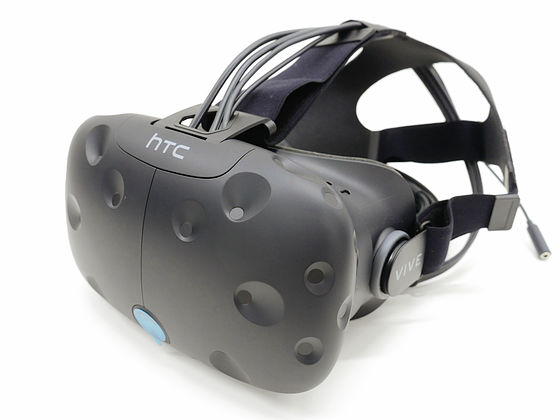Potential for VR to serve as a cure for overcoming various phobias

by Billetto Editorial
It is " phobia " that feels abnormal fear for certain certain things, from relatively commonly heard things such as afraid of the heights or tip phobia to creatures such as social phobia and animal phobia There are various kinds of things to embrace. A woman with "phobophobia" which is such a type of phobia has succeeded in overcoming phobia by receiving treatment with VR, and effective means for VR to overcome various phobias It is attracting attention as it becomes.
Journal of Anxiety Disorders - Elsevier
https://www.journals.elsevier.com/journal-of-anxiety-disorders
VR Therapy Makes Arachnophobes Braver Around Real Spiders - IEEE Spectrum
https://spectrum.ieee.org/the-human-os/biomedical/devices/spider-video-therapy
Usually, " overtreatment therapy " which is a type of behavioral therapy is used to overcome phobia. Exposure therapy will encourage patients to face subjects of fear, but in the case of airborne phobia or phobia related to large animals, for example, it was difficult to use exposure therapy.
For that reason, " CG and VR-based methods " have attracted attention as a new type of exposure therapy in recent years. The patient can safely fight against the subject of fear in the virtual space, and even if it is difficult situation to realize with normal exposure therapy, it is easily reproducible.
A research team at the University of Texas at Austin is conducting an experiment that women with spider phobia overcome spiders using exposure therapy using VR. In the experiment, women wear a VR headset and watched the 3D video of about 5 minutes that "Tarantula walks over the hand and creeps up towards the face gradually over time" while sitting on the chair I will. Although we watch this image six times in the experiment, we do not use real tarantula, so subjects can be safely and repeatedly exposed to their own fears.

In the experiment, 77 college students who are afraid of spiders are collected, and we try to overcome phobia using VR and live-action 3D images. The subjects seemed to have not shown fears like before even if they faced real spiders when they saw the image of Tarantula in VR for 30 minutes. In addition, it was a relatively large size tarantula among the spiders called "Chile Uncommon Tarantula" that the subject was confronted after the experiment.
Mr. Shaun Mins, a graduate student at Columbia University, invented the experiment, "During the experiment I knew how uncomfortable the subject was physically, as many people came back as the tarantula approached "I talk about the situation of the subject during the experiment. However, these reactions seem to be preferable, as they are evidence that they respond as though they are experiencing simulations with VR as if they were real experiences.
The 3D image used in the experiment was actually taken with a stereoscopic 3D dual camera rather than being created with CG. What was used for shooting was to take pictures simultaneously with two cameras that imitated the natural distance between the eyes so that they could express the realism as though they were watching actual images And was adopted. By reproducing this image with Oculus Rift, the subject seems to have felt the depth to the image.

In order to investigate whether exposure therapy using VR was successful, researchers used the live Chilean uncommon tarantula to test "how sparious a subject is a subject" before and after the treatment experiment. Prepare a Chile Uncommon Tarantula in a transparent case and create 14 different steps to measure how much fear the subject has in the spider. "Fourteen different steps" means that by having the subject perform tasks such as "putting both hands in the case" or "putting the tarantula on the palm and taking out from the case", the most advanced task is " Hold the tarantula for 15 seconds ".
The average level of subjects before treatment was "7", which was "to put one hand in the middle of the case containing the tarantula". However, when experiencing exposure therapy using VR, the average level of subjects increased to "10.5", he said that he was able to complete the task of "putting the palm in the case containing tarantula". Some people may feel that "There has not been so much improvement", Mr. Minz said, "This improvement is very important clinically."

This study is not done on people diagnosed with phobia, but is limited in that it targets people who feel "spider is scary" to the last. Also, it is an example using 3D images shot with the camera, and we are not investigating how much difference is produced in 3D CG video created with 3D video and CG.
Emily Karl, a student at the University of Texas at Austin who participated in the study said, "There is evidence that computer generated virtual reality is as effective as normal exposure therapy, but CG video is" We are not very realistic and are distracted, "he says. As for what this means, if you make a robot that resembles a human being, if you exceed a certain line, the " eerie valley phenomenon " in which the emotional reaction of humans drastically drops can also occur in exposure therapy using VR And that. Mr. Karl said, "For example, suppose you made a picture of a room with many people made with CG to overcome social social anxiety disorder , even if people made with CG were not so humane, If they are intimate, the patient may become focused on it, which states that they are cheating patients without saying that it is not necessarily effective as a treatment. It seems that there are cases where it is not possible to fully demonstrate the effect of exposure therapy in 3D images made with only CG.
Related Posts:






